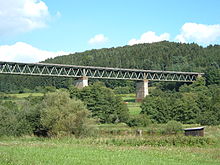Laberviaduct
The Laberviadukt or the Deininger Bridge is a 306 meter long railway bridge southeast of Neumarkt in the Upper Palatinate . Here the railway line Nuremberg – Regensburg crosses the valley of the Weißen Laber in the municipality of Deining .
history
The need to cross the valley
When the AG der Bayerische Ostbahnen began planning a route from Nuremberg to Neumarkt to Regensburg in 1869, a route from Neumarkt was initially planned further north via Velburg to Seubersdorf . However, due to considerable dissenting votes in the Velburg magistrate, implementation failed, so that the route had to be led through the much more demanding terrain via Deining and Batzhausen. A different route was practically impossible, as this is the only way to climb the Franconian Alb . Among other things, the valley of the White Laber now had to be crossed. In order not to make such a valley crossing too costly, a 340 meter long tunnel was initially planned near Kleinalfalterbach so that the railway line could not cross the valley at too great a height. However, test drilling quickly led to the realization that the sandstone in the region around Deining was very brittle and completely unsuitable for tunneling with the technical possibilities of the time. It was decided to lead the route only through a cut in the terrain to be excavated. The excavated material was then immediately used for embankments around the bridge.
Complicated construction work
Construction work on the bridge began in the autumn of 1870. First, the embankment began with the embankment, which in March 1871 was already 132 meters long and 16 meters high. The embankment coming from the east was to be followed by a straight bridge supported by two pillars. The resulting spaces should each be 60 meters long. Due to heavy rain, however, there was a severe setback. On the night of March 20, 1871, the entire dam began to slide, tore the abutment (end pillar) that had been started on the bridge with it and rolled into the valley so that nothing was left of the actual dam.
The entire bridge has now been redesigned. It was set higher; four pillars should now be erected at a distance of 72 meters each. Because the bridge was lengthened by 150 meters, the straight stretch now turns into a curve in the middle of the bridge. Numerous sandstone blocks were broken in the vicinity. In the valley next to the bridge, a wooden falsework was built for the assembly of the iron trusses . Numerous workers were employed on the construction site not only from southern Germany, but also from Austria and Italy. For these, numerous apartments were built around the already completed station building, and the Deining-Bahnhof settlement was created.
Together with the Neumarkt – Seubersdorf section, the single-track bridge was inaugurated and put into operation on May 15, 1873. The construction costs were given as 32,077,406 marks .
Expansion for double-track operation
The AG der Bayerische Ostbahnen was taken over by the Kingdom of Bavaria in 1875 , thereby nationalizing all rail traffic on the route. In order to increase the capacity of the line, concrete planning for the double-track expansion that was originally planned was started. Since the abutment and pillar of the bridge had already been built correspondingly wide, the planning and cost effort remained low. In 1895 the necessary load tests were carried out with two steam locomotives and the second track was also opened to traffic. This enabled the timetable between Neumarkt and Regensburg to be significantly condensed.
Further expansion and general overhaul
As the locomotives and wagons got bigger and heavier over time, the entire bridge was reinforced in its construction in 1925. The railway line was electrified as early as 1949. The biggest problem, however, was the curve that began in the middle of the bridge: trains were only allowed to cross the bridge at a speed of 50 km / h, train encounters on the bridge had to be avoided. The Deutsche Bundesbahn therefore decided to completely overhaul the bridge. This work was carried out from 1960 to 1969 during ongoing operations. The joints of the masonry pillars were sprayed with cement glue, the steel framework was renewed and a supporting surface made of reinforced concrete was placed underneath in order to better distribute the load. A total of 950 tons of steel and more than 38,000 screws were used.
This work increased the load limits of the bridge. Nowadays, trains can easily drive over the bridge together, ICE trains cross the Labertal at speeds of up to 120 km / h.
Web links
Coordinates: 49 ° 12 ′ 8 ″ N , 11 ° 32 ′ 17 ″ E


